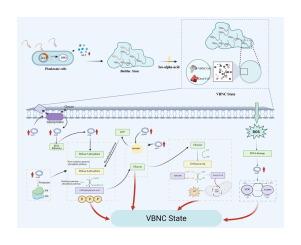Mechanism insights into the regulation of the LuxS/AI-2 quorum sensing system on the formation of viable but nonculturable state in biofilm cells of beer-spoilage Lactiplantibacillus plantarum
IF 13
1区 综合性期刊
Q1 MULTIDISCIPLINARY SCIENCES
引用次数: 0
Abstract
Introduction
Beer spoilage Lactiplantibacillus plantarum poses a significant challenge in brewing due to biofilm formation and entry into the viable but nonculturable (VBNC) state, evading detection and resisting sterilization. The LuxS/AI-2 quorum sensing (QS) system is implicated in stress adaptation, yet its regulatory role in biofilm-associated VBNC transition remains poorly understoodObjectives
This study aims to elucidate how the luxS gene regulates VBNC-state formation in biofilm-embedded L. plantarum under hop-derived iso-α-acid stress and to identify molecular mechanisms underlying QS-mediated adaptation and resuscitation.Methods
Wild-type and genetically engineered L. plantarum strains (ΔluxS, luxS-overexpressing) were exposed to iso-α-acids to induce VBNC states. Morphological changes were analyzed via scanning electron microscopy. Temporal luxS expression and AI-2 levels were quantified using qRT-PCR and bioluminescence assays. Multi-omics (transcriptomics, proteomics, ChIP-seq) and phenotypic analyses assessed metabolic reprogramming, gene regulation, and resuscitation dynamics.Results
Iso-α-acids (27 mg/L) induced complete VBNC transition in biofilms within 12 h, with cells exhibiting reduced volume and surface polymer deposition. luxS expression and AI-2 levels synchronized during induction, peaking at 4 h. Overexpression of luxS accelerated VBNC entry and enhanced resuscitation (>103 CFU/mL recovery), while ΔluxS impaired both processes. Multi-omics revealed luxS activation of carbohydrate metabolism (e.g., pgmB, rbsUDK operon) and stress-response genes (nrdD, pepc). ChIP-seq confirmed direct LuxS binding to promoter regions of these genes, orchestrating energy homeostasis and oxidative defense via pentose phosphate and ABC transporter pathways.Conclusion
The LuxS/AI-2 QS system governs biofilm-to-VBNC transition in L. plantarum by modulating metabolic resilience and stress adaptation. These findings provide a molecular framework for targeting QS pathways to mitigate biofilm persistence and spoilage risks in brewing industries.

LuxS/AI-2群体感应系统调控啤酒腐坏植物乳杆菌生物膜细胞形成活但不可培养状态的机制探讨
植物乳杆菌(lactoplantibacillus planum)在啤酒酿造过程中形成生物膜,进入可存活但不可培养(viable but non - culable, VBNC)状态,逃避检测和抵抗杀菌,对啤酒酿造造成了重大挑战。LuxS/AI-2群体感应(quorum sensing, QS)系统与胁迫适应有关,但其在生物膜相关的VBNC转变中的调控作用尚不清楚。目的本研究旨在阐明LuxS基因在啤酒花来源的异α-酸胁迫下如何调控植物生物膜内的VBNC状态形成,并确定QS介导的适应和复苏的分子机制。方法将野生型和转基因植物乳杆菌(ΔluxS, luxs过表达)暴露于异α-酸中诱导VBNC状态。通过扫描电镜分析其形态学变化。采用qRT-PCR和生物发光法定量分析luxS的时间表达和AI-2水平。多组学(转录组学、蛋白质组学、ChIP-seq)和表型分析评估了代谢重编程、基因调控和复苏动力学。结果iso -α-酸(27 mg/L)在12 h内诱导生物膜完全转化VBNC,细胞体积减小,表面聚合物沉积。luxS表达与AI-2水平在诱导过程中同步,在4 h达到峰值。过表达luxS加速VBNC进入和增强复苏(103 CFU/mL恢复),而ΔluxS损害这两个过程。多组学显示luxS激活了碳水化合物代谢(如pgmB, rbsUDK操纵子)和应激反应基因(nrdD, pepc)。ChIP-seq证实LuxS与这些基因的启动子区域直接结合,通过戊糖磷酸和ABC转运蛋白途径协调能量稳态和氧化防御。结论LuxS/AI-2 QS系统通过调节植物的代谢恢复力和应激适应性,调控植物生物膜向vbnc的转变。这些发现为针对QS途径减轻酿造业生物膜持久性和腐败风险提供了分子框架。
本文章由计算机程序翻译,如有差异,请以英文原文为准。
求助全文
约1分钟内获得全文
求助全文
来源期刊

Journal of Advanced Research
Multidisciplinary-Multidisciplinary
CiteScore
21.60
自引率
0.90%
发文量
280
审稿时长
12 weeks
期刊介绍:
Journal of Advanced Research (J. Adv. Res.) is an applied/natural sciences, peer-reviewed journal that focuses on interdisciplinary research. The journal aims to contribute to applied research and knowledge worldwide through the publication of original and high-quality research articles in the fields of Medicine, Pharmaceutical Sciences, Dentistry, Physical Therapy, Veterinary Medicine, and Basic and Biological Sciences.
The following abstracting and indexing services cover the Journal of Advanced Research: PubMed/Medline, Essential Science Indicators, Web of Science, Scopus, PubMed Central, PubMed, Science Citation Index Expanded, Directory of Open Access Journals (DOAJ), and INSPEC.
 求助内容:
求助内容: 应助结果提醒方式:
应助结果提醒方式:


